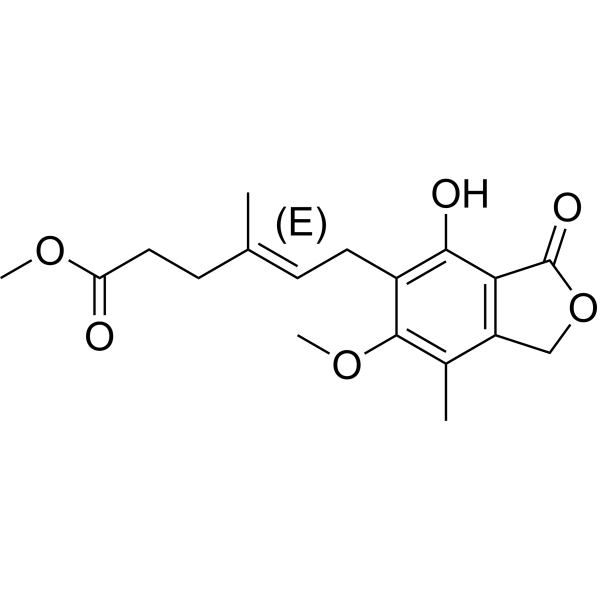
Methyl mycophenolate
CAS No. 31858-66-9
Methyl mycophenolate( Mycophenolic Acid Methyl Ester )
Catalog No. M27089 CAS No. 31858-66-9
Methyl mycophenolate is found in the marine fungus Phaeosphaeria spartinae. Methyl mycophenolate is the methyl ester form of mycophenolic acid.
Purity : >98% (HPLC)
 COA
COA
 Datasheet
Datasheet
 HNMR
HNMR
 HPLC
HPLC
 MSDS
MSDS
 Handing Instructions
Handing Instructions
| Size | Price / USD | Stock | Quantity |
| 5MG | 53 | Get Quote |


|
| 10MG | 95 | Get Quote |


|
| 25MG | 192 | Get Quote |


|
| 50MG | 286 | Get Quote |


|
| 100MG | 426 | Get Quote |


|
| 200MG | Get Quote | Get Quote |


|
| 500MG | Get Quote | Get Quote |


|
| 1G | Get Quote | Get Quote |


|
Biological Information
-
Product NameMethyl mycophenolate
-
NoteResearch use only, not for human use.
-
Brief DescriptionMethyl mycophenolate is found in the marine fungus Phaeosphaeria spartinae. Methyl mycophenolate is the methyl ester form of mycophenolic acid.
-
DescriptionMethyl mycophenolate is found in the marine fungus Phaeosphaeria spartinae. Methyl mycophenolate is the methyl ester form of mycophenolic acid.
-
In Vitro——
-
In Vivo——
-
SynonymsMycophenolic Acid Methyl Ester
-
PathwayOthers
-
TargetOther Targets
-
RecptorM3 mAChR
-
Research Area——
-
Indication——
Chemical Information
-
CAS Number31858-66-9
-
Formula Weight334.36
-
Molecular FormulaC18H22O6
-
Purity>98% (HPLC)
-
SolubilityIn Vitro:?DMSO : 100 mg/mL (299.08 mM)
-
SMILESO=C(OC)CC/C(C)=C/CC1=C(O)C2=C(COC2=O)C(C)=C1OC.[(E)]
-
Chemical Name——
Shipping & Storage Information
-
Storage(-20℃)
-
ShippingWith Ice Pack
-
Stability≥ 2 years
Reference
1.Houghton LA, et al. Zamifenacin (UK-76, 654) a potent gut M3 selective muscarinic antagonist, reduces colonic motor activity in patients with irritable bowel syndrome. Aliment Pharmacol Ther. 1997 Jun;11(3):561-8.
molnova catalog



related products
-
ISA-2011B
ISA-2011B is an inhibitor of PIP5K1α and can be used in anticancer studies.
-
8-Methyl Chrysophano...
8-Methyl Chrysophanol is an anthraquinone isolated from the bark of?Senna macranth.
-
2,11,12-Trihydroxy-7...
The herbs of Teucrium viscidum.



 Cart
Cart
 sales@molnova.com
sales@molnova.com


